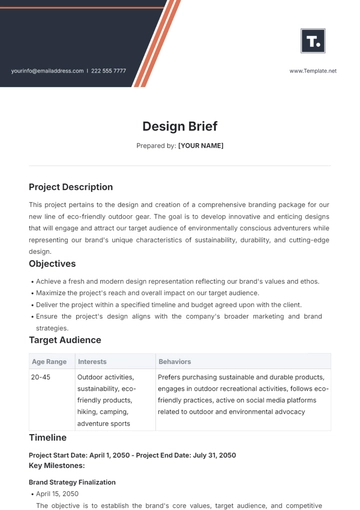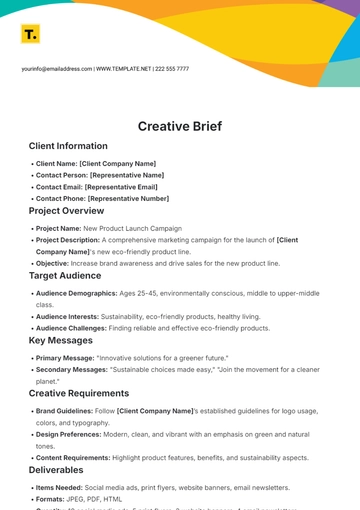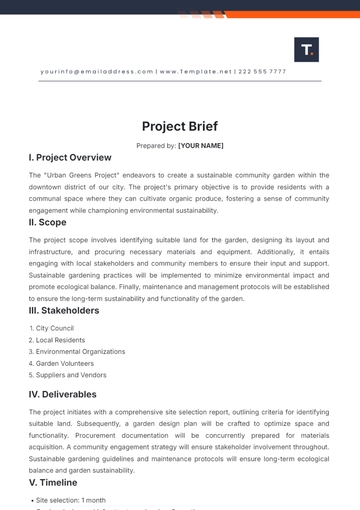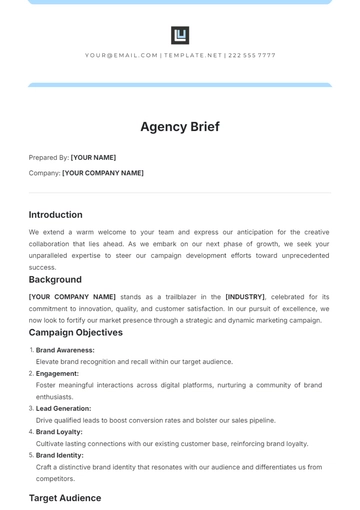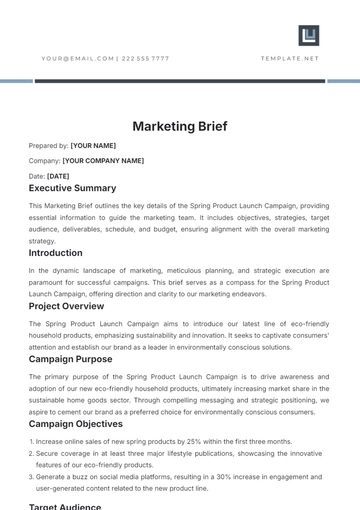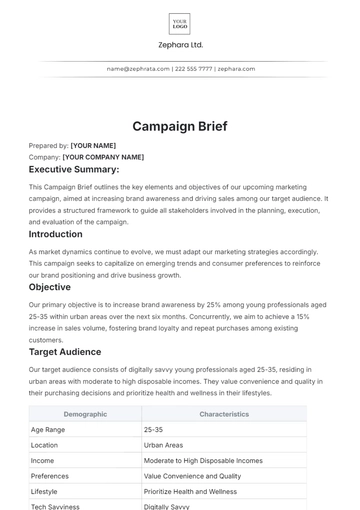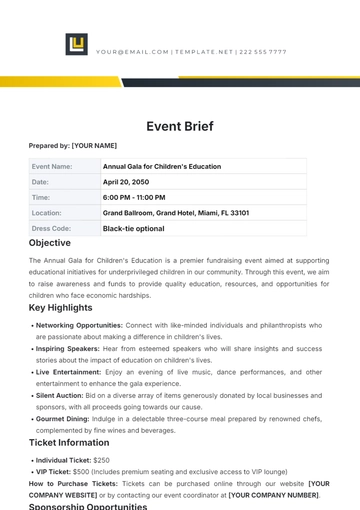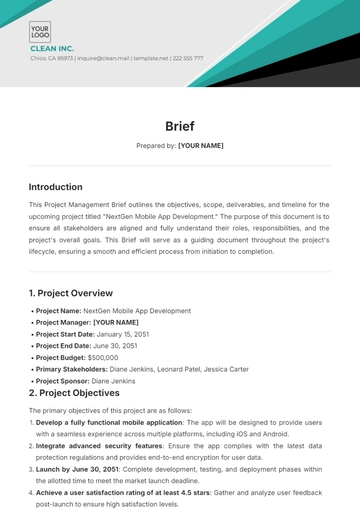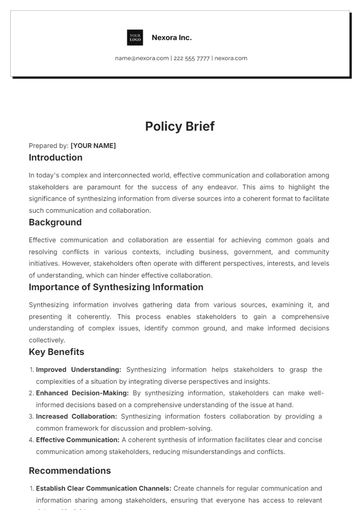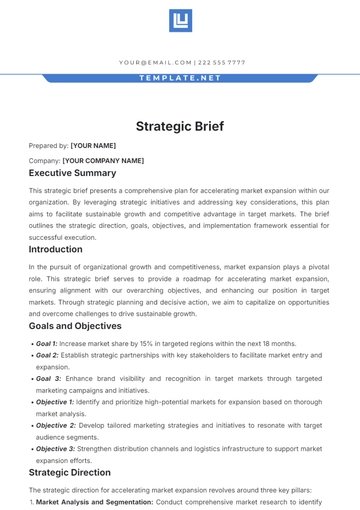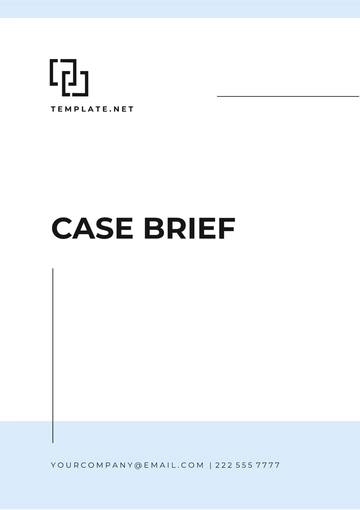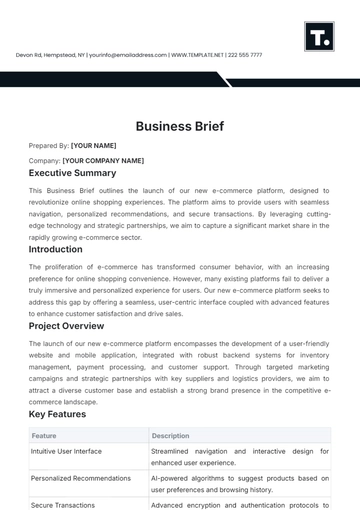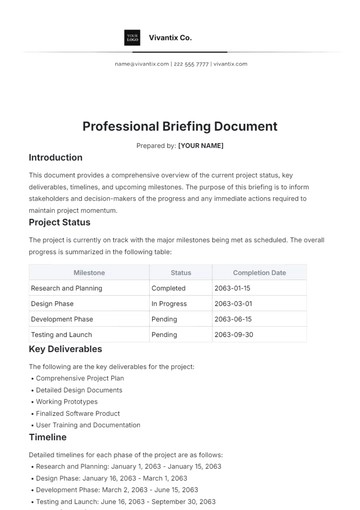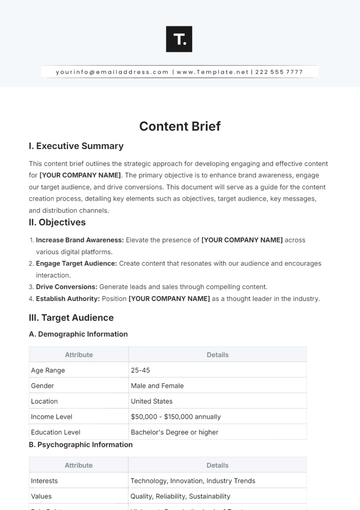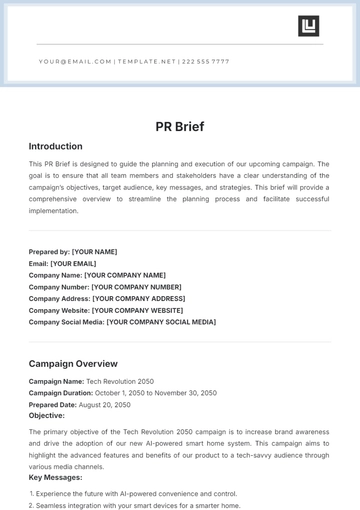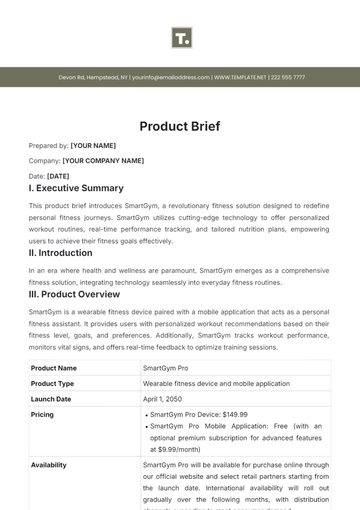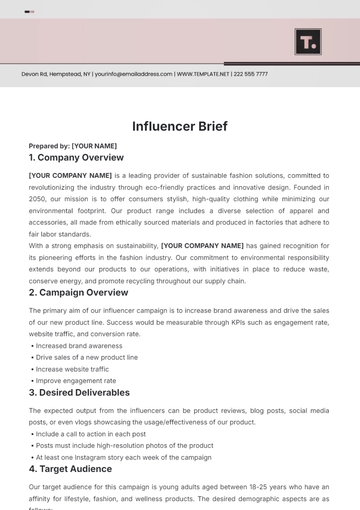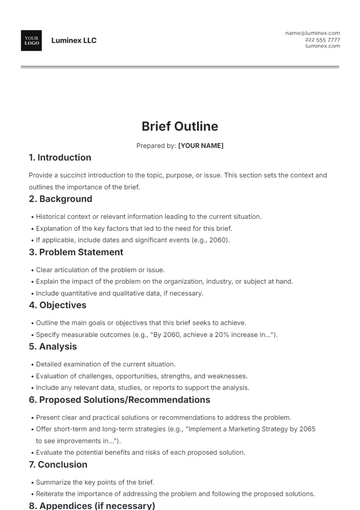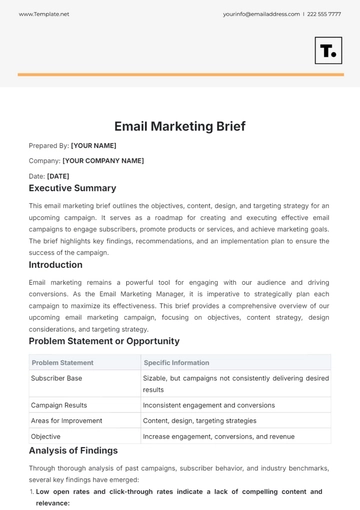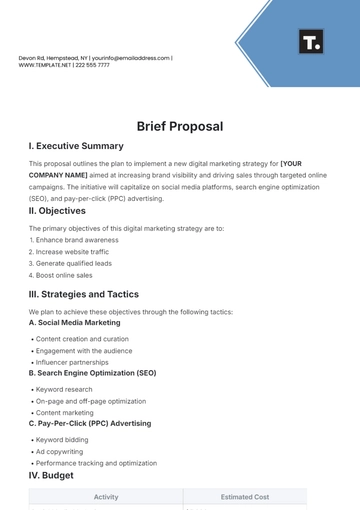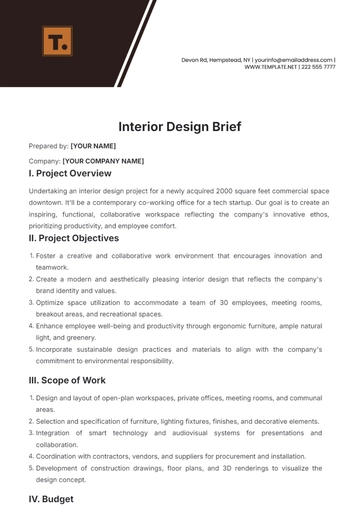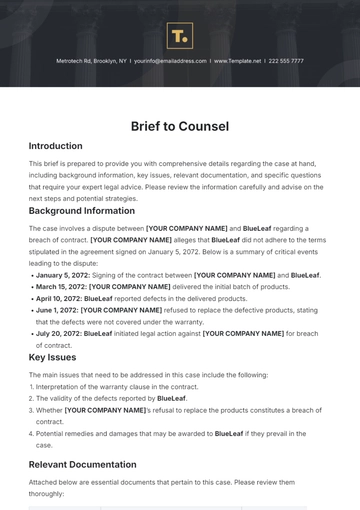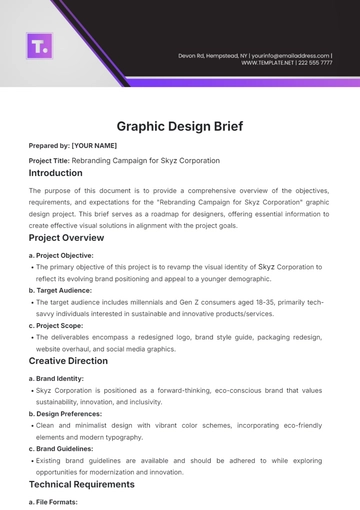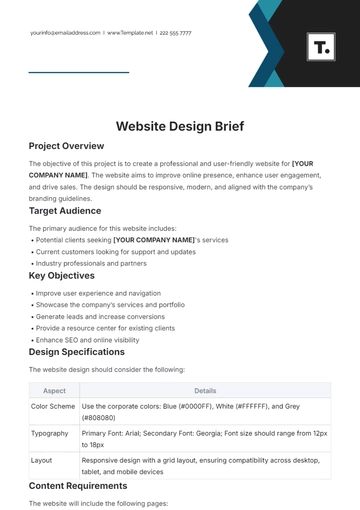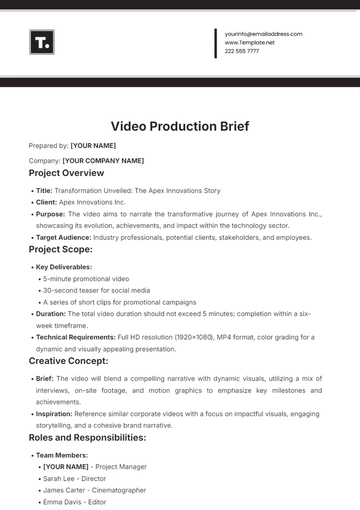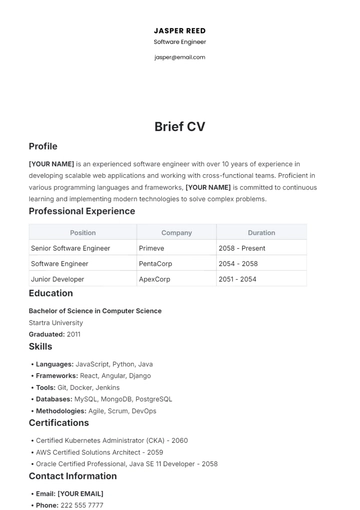Free Agile Project Brief

Prepared By: [YOUR NAME]
Company: [YOUR COMPANY NAME]
Date: [DATE]
Executive Summary
This project overview highlights the essential aspects of our Agile project, focusing on delivering high-quality solutions, adapting to changing requirements, fostering collaboration, and continuously improving team efficiency. The structure encompasses the project's purpose, objectives, roles, scope, milestones, and risk management strategies. By embracing Agile methodologies, we aim to maximize flexibility and responsiveness, ensuring successful outcomes aligned with stakeholder needs.
Introduction
This document, provides a comprehensive overview of the project, emphasizing its significance, goals, key components, and risk management strategies. This introduction sets the stage for understanding the project's scope and how it aligns with organizational objectives. Through effective collaboration and adherence to Agile principles, we aim to deliver value-added solutions while mitigating potential risks and ensuring stakeholder satisfaction. Let's delve into the details of each section to gain a deeper understanding of our project's framework and objectives.
Project Overview
This project aims to develop a comprehensive waste management system for [YOUR COMPANY ADDRESS] to address increasing waste generation. Benefits include environmental protection, improved public health, and enhanced city aesthetics. The timeline is as follows:
Initiation (Month 1-2): Assess current practices, define objectives, and establish stakeholders.
Planning (Month 3-4): Develop a detailed waste management plan and secure permits.
Implementation (Month 5-10): Procure equipment, deploy infrastructure, and conduct awareness campaigns.
Monitoring (Month 11-12): Track effectiveness, evaluate impact, and refine strategies.
Delivery (Month 13): Review outcomes, prepare documentation and hand over the system.
The project will improve living standards and promote sustainable waste management practices.
Project Objectives
The core objectives of this agile project are to:
Deliver High-Quality Solutions: Ensure that the solutions provided not only meet but exceed customer expectations in terms of functionality, reliability, and usability. Implement rigorous testing and quality assurance measures throughout the development process to achieve this objective.
Adapt Quickly to Evolving Requirements: Embrace change and be responsive to evolving project requirements by utilizing agile methodologies such as Scrum or Kanban. Maintain open lines of communication with stakeholders to promptly address any changes or updates to project specifications.
Promote a Collaborative, Learning-Focused Work Environment: Foster a culture of collaboration, where team members feel empowered to share ideas, provide feedback, and learn from one another. Encourage knowledge-sharing sessions, cross-functional training, and regular team meetings to facilitate continuous learning and improvement.
Continually Improve Team Efficiency and Performance: Regularly assess team performance and identify areas for improvement. Implement strategies such as retrospectives to reflect on past successes and failures, and adjust processes accordingly. Encourage innovation and experimentation to optimize team efficiency and productivity.
Ensure Stakeholder Satisfaction: Prioritize stakeholder satisfaction by maintaining transparent communication channels, providing regular updates on project progress, and soliciting feedback at every stage of the development cycle. Address any concerns or issues promptly to ensure that stakeholder expectations are consistently met or exceeded.
Maintain Focus on Business Value: Keep the project aligned with the overall business objectives and ensure that the solutions delivered provide tangible value to the end-users and stakeholders. Regularly assess the project's progress against key performance indicators (KPIs) and adjust priorities as necessary to maximize ROI and business impact.
Roles and Responsibilities
This section outlines the key project roles, along with their responsibilities. Each role has a crucial part to play in the project's success. The following table presents a breakdown of our project team roles:
Role | Responsibility |
|---|---|
Product Owner | Defines product features, communicates objectives, prioritizes work |
Scrum Master | Enables team productivity, removes obstacles, safeguards the team's process |
Development Team | Delivers potentially releasable increments of work at the end of each sprint |
Project Scope
The scope of our project includes the following key features or functions:
Feature 1: User Authentication System
Description: Implement a secure user authentication system allowing users to sign up, log in, and manage their accounts.
Purpose: This feature is crucial for ensuring data security and providing personalized user experiences.
Key Deliverables:
User registration form with validation.
Secure password hashing and storage.
Login functionality with session management.
Account management features such as password reset and profile updates.
Timeline: Approximately 2 weeks for development and testing.
Stakeholders: Development team, security team, product owners, end users.
Feature 2: Product Catalog
Description: Develop a comprehensive product catalog where users can browse, search, and view detailed information about available products.
Purpose: To provide users with a seamless shopping experience and facilitate informed purchasing decisions.
Key Deliverables:
Database schema for storing product information.
User interface for browsing and searching products.
Product detail pages with images, descriptions, and pricing.
Timeline: Estimated completion within 3 weeks, including testing and refinement.
Stakeholders: Development team, product managers, UX/UI designers, end users.
Feature 3: Shopping Cart and Checkout
Description: Implement a shopping cart functionality allowing users to add products, update quantities, and proceed to checkout for payment.
Purpose: To enable users to conveniently purchase selected items and complete transactions securely.
Key Deliverables:
Shopping cart interface with add/remove functionality.
Checkout process with shipping and billing information collection.
Integration with payment gateway for processing transactions.
Timeline: Anticipated completion within 4 weeks, including testing and integration.
Stakeholders: Development team, QA team, finance department, end users.
Feature 4: Order Management
Description: Develop an order management system for tracking and managing customer orders from placement to fulfillment.
Purpose: To streamline order processing and ensure timely delivery of products.
Key Deliverables:
Order database schema with status tracking.
Admin interface for managing orders, including status updates and order fulfillment.
Email notifications for order confirmation, shipment, and delivery.
Timeline: Estimated completion within 3 weeks, subject to testing and feedback.
Stakeholders: Development team, operations team, customer support, end users.
Key Milestones
This section outlines the critical milestones in the project. By continuously reviewing and updating these milestones in line with Agile principles, we can maintain the relevance and quality of our outputs. The estimated milestones are:
Milestone 1 - Initial Planning and Requirements Gathering March 15, 2050
This milestone involves conducting stakeholder meetings, gathering project requirements, and defining the scope and objectives of the project. It includes creating a project plan, setting up communication channels, and assembling the project team.
Milestone 2 - Prototype Development April 30, 2050
During this phase, the team will focus on developing a prototype or proof of concept based on the gathered requirements. This milestone involves rapid iteration and feedback loops to refine the prototype according to user needs and project goals.
Conducting user research and feedback sessions to validate the prototype's design and functionality from April 1, 2050, to April 15, 2050.
Iterating on the prototype based on user feedback and technical feasibility from April 16, 2050, to April 25, 2050.
Testing the prototype in different environments to ensure compatibility and performance from April 26, 2050, to April 30, 2050.
Documenting the prototype's architecture, design decisions, and future development roadmap by April 30, 2050.
Milestone 3 - Alpha Release June 15, 2050
The alpha release marks the completion of the initial development phase. The team will deliver a functional but potentially incomplete version of the product to internal stakeholders for testing and feedback. This milestone is crucial for identifying any major issues or deficiencies early in the development process.
Milestone 4 - Beta Release August 10, 2050
The beta release signifies a more polished version of the product ready for external testing. This milestone involves addressing feedback from the alpha release, fixing bugs, and implementing additional features or improvements based on user input. The beta version aims to gather real-world feedback from a wider audience to further refine the product before the final release.
Risks and Mitigation
Identifying potential risks and preparing mitigation strategies is a crucial element of any Agile project. The following are some of the potential risks we've identified for this project, along with suggested responses:
Risk: Key team members leaving the project unexpectedly
Response:
Cross-train team members
Maintain ongoing communication
Develop succession plans
Risk: Technology platform dependencies
Response:
Regularly assess platform stability
Diversify platform usage
Develop contingency plans
Risk: Inadequate stakeholder engagement
Response:
Establish clear communication channels
Regularly update stakeholders
Solicit feedback and involve stakeholders in decision-making
- 100% Customizable, free editor
- Access 1 Million+ Templates, photo’s & graphics
- Download or share as a template
- Click and replace photos, graphics, text, backgrounds
- Resize, crop, AI write & more
- Access advanced editor
Introducing the Agile Project Brief Template, exclusively on Template.net. This customizable and editable tool is ideal for dynamic project management. Seamlessly tailor your agile project outlines using our intuitive Ai Editor Tool, ensuring adaptability and clarity at every stage. Elevate your project management strategy with a template designed for seamless collaboration and unparalleled agility.
